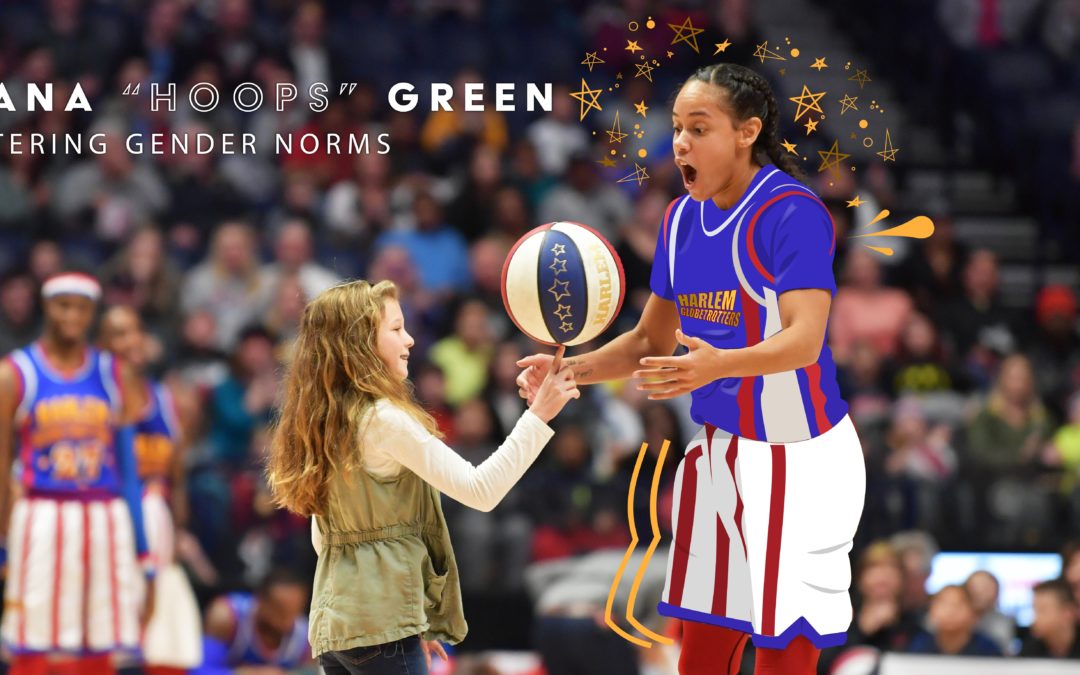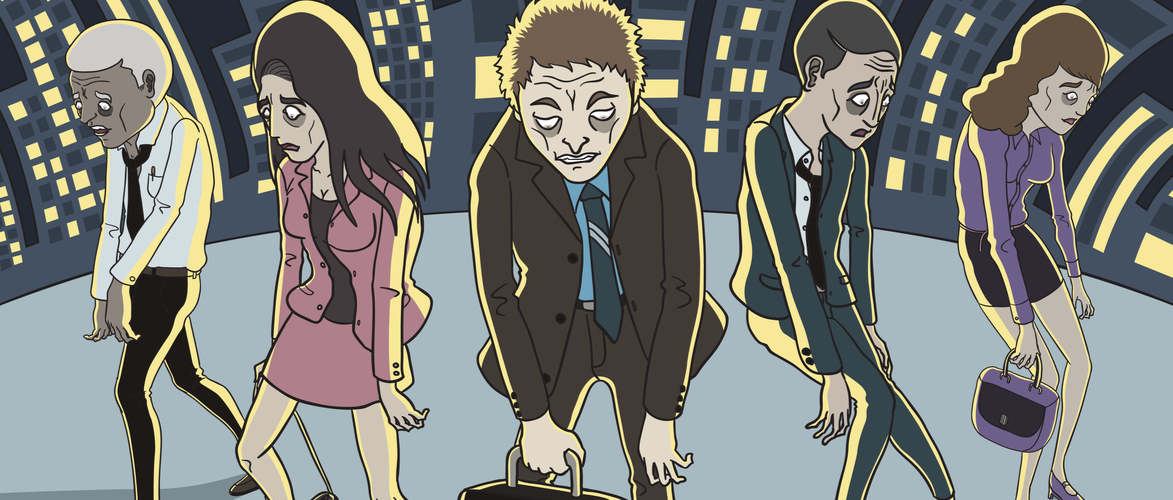
by American Business Women's Association | Feb 1, 2019 | Blog
By Leigh Elmore. Leigh is editor-at-large for ABWA’s Women in Business Magazine. He lives and works in Kansas City, MO.
Flashy dribbler for the Harlem Globetrotters takes it to her male competitors. If you play for the Harlem Globetrotters, then you have to have a nickname. Many people “of a certain age” can remember some nicks of the Globetrotters’ past: “Meadowlark” Lemon and Fred “Curly” Neal, for example.
Well, move over guys, because these days the three traveling squads of Harlem Globetrotters boast players with the names such as “Champ” Thompson, “Ice” Hrynko, “Torch” George, “TNT” Lister, “Mighty” Mortimer, “Swish” Young and Briana “Hoops” Green, the seven women currently listed on the Globetrotters’ roster.
Green is the 15th woman to don the red, white and blue Globetrotters uniform, beginning with Lynette Woodard who joined the team in 1985.
“I first saw the Globetrotters when I was seven years old,” Green told ABWA recently. “I didn’t know who they were, but I certainly was entertained and impressed. But, at that young age I already knew that I wanted to play basketball professionally.”
During that time period Green was regularly playing pick-up ball with her older brother and other kids in the neighborhood of her hometown, Lexington, KY. She later went on to star on her high school team, Lexington Catholic, and helped the team garner two state championships on her way to playing college ball at the University of Texas-El Paso. Green would then play professionally in the Czech Republic, Spain and Mexico.
However, in 2017 she felt like she needed a change. “I was trying to figure out if I wanted to continue to play professionally overseas,” said Green. “It just so happened that I posted a video on Facebook of me dribbling, and the video went viral. Everybody was tagging the Globetrotters and how I should be on the team so a recruiter saw it and he invited me to try out.”
And the rest as we say is history. She was invited to join the team where she fills one of the roles as ball-handler and flashy dribbler. Now in her third year with the Globetrotters, she noted that she had played against boys from an early age and, “I played on a lot of co-ed teams,” along the way as well.
“As far as my dribbling ability, I think I can compete with the best of them. The dribbling part always came naturally,” she said. It’s the Globetrotters’ entertaining repertoire of tricks that she needed to practice. “I do have to work on it.”
Since her debut with the Globetrotters, Green has learned a lot from the teammates she calls brothers. Being a Globetrotter is all about providing entertainment—about mixing real, competitive basketball with the signature tricks and routines that fans have come to know and love. At the same time, it’s also about service and using the iconic Globetrotters brand for good.
“We are known for being ambassadors of good will,” she said. “It’s about being good role models for kids.” She says some of her favorite moments are talking to kids after the games. “I’m used to little girls looking up to another girl, but when a younger guy comes up to me and tells me that I’m their favorite basketball player, I’m like, ‘Yeah, we can do this!’” she said.
She and her teammates visit a lot of schools and hospitals as part of the Globetrotters’ goodwill efforts.
The Harlem Globetrotters have always been enthralling and accessible. But, by including female athletes in their engaging routines, they’ve anchored a new demographic: Girls. The women on their active roster have become role models for young women everywhere. While leagues like the Women’s National Basketball Association (WNBA) and the National Collegiate Athletic Association (NCAA) also showcase women’s basketball, playing on the Globetrotters gives Hoops and her female teammates a unique chance to match up against talented male athletes.
“It’s important that everyone knows that women are more than capable of competing at that level,” she said, “not just with basketball, with anything.”
by American Business Women's Association | Feb 1, 2019 | Uncategorized
By Leigh Elmore. Leigh is editor-at-large for ABWA’s Women in Business Magazine. He lives and works in Kansas City, MO.
Flashy dribbler for the Harlem Globetrotters takes it to her male competitors. If you play for the Harlem Globetrotters, then you have to have a nickname. Many people “of a certain age” can remember some nicks of the Globetrotters’ past: “Meadowlark” Lemon and Fred “Curly” Neal, for example.
Well, move over guys, because these days the three traveling squads of Harlem Globetrotters boast players with the names such as “Champ” Thompson, “Ice” Hrynko, “Torch” George, “TNT” Lister, “Mighty” Mortimer, “Swish” Young and Briana “Hoops” Green, the seven women currently listed on the Globetrotters’ roster.
Green is the 15th woman to don the red, white and blue Globetrotters uniform, beginning with Lynette Woodard who joined the team in 1985.
“I first saw the Globetrotters when I was seven years old,” Green told ABWA recently. “I didn’t know who they were, but I certainly was entertained and impressed. But, at that young age I already knew that I wanted to play basketball professionally.”
During that time period Green was regularly playing pick-up ball with her older brother and other kids in the neighborhood of her hometown, Lexington, KY. She later went on to star on her high school team, Lexington Catholic, and helped the team garner two state championships on her way to playing college ball at the University of Texas-El Paso. Green would then play professionally in the Czech Republic, Spain and Mexico.
However, in 2017 she felt like she needed a change. “I was trying to figure out if I wanted to continue to play professionally overseas,” said Green. “It just so happened that I posted a video on Facebook of me dribbling, and the video went viral. Everybody was tagging the Globetrotters and how I should be on the team so a recruiter saw it and he invited me to try out.”
And the rest as we say is history. She was invited to join the team where she fills one of the roles as ball-handler and flashy dribbler. Now in her third year with the Globetrotters, she noted that she had played against boys from an early age and, “I played on a lot of co-ed teams,” along the way as well.
“As far as my dribbling ability, I think I can compete with the best of them. The dribbling part always came naturally,” she said. It’s the Globetrotters’ entertaining repertoire of tricks that she needed to practice. “I do have to work on it.”
Since her debut with the Globetrotters, Green has learned a lot from the teammates she calls brothers. Being a Globetrotter is all about providing entertainment—about mixing real, competitive basketball with the signature tricks and routines that fans have come to know and love. At the same time, it’s also about service and using the iconic Globetrotters brand for good.
“We are known for being ambassadors of good will,” she said. “It’s about being good role models for kids.” She says some of her favorite moments are talking to kids after the games. “I’m used to little girls looking up to another girl, but when a younger guy comes up to me and tells me that I’m their favorite basketball player, I’m like, ‘Yeah, we can do this!’” she said.
She and her teammates visit a lot of schools and hospitals as part of the Globetrotters’ goodwill efforts.
The Harlem Globetrotters have always been enthralling and accessible. But, by including female athletes in their engaging routines, they’ve anchored a new demographic: Girls. The women on their active roster have become role models for young women everywhere. While leagues like the Women’s National Basketball Association (WNBA) and the National Collegiate Athletic Association (NCAA) also showcase women’s basketball, playing on the Globetrotters gives Hoops and her female teammates a unique chance to match up against talented male athletes.
“It’s important that everyone knows that women are more than capable of competing at that level,” she said, “not just with basketball, with anything.”

by American Business Women's Association | Jan 31, 2019 | Blog
By Ted Janusz, MBA, CSP. Ted is a Certified Speaking Professional who has delighted audiences for more than 5,000 hours, in 49 of the 50 United States, in Canada from Halifax to Vancouver, in Australia, Mexico, and Puerto Rico. Learn more at www.januspresentations.com.
Do you need to write copy for a brochure or sales letter? I teach a copywriting workshop, so just for fun, I signed on to edit and write brochures and sales letters as a freelancer on Fiverr.com.
And it has been a blast! I have had the enjoyable opportunity to work with fun individuals all over the world, from a health and wellness practitioner in Ireland to a tour operator in Russia.
These professionals know their business, as I am sure that you do, too. But, as we shall soon see, that might actually be a detriment when trying to explain to others what you do. When composing a brochure or sales letter to describe your organization, avoid these four mistakes:
- Being “you” focused rather than “they” focused. Of course, you understand your business, and are anxious to tell others everything about what you do. Guess what? They don’t care! (At least, not yet.) The first thing you need to do is to write text that relates to them. (Notice how I did that from the first sentence in this article.)
- Providing too much detail. With a brochure, provide just enough information so that the future customer will want to contact you to get more details. One of the best ways to do this is to start with a story. And make the story be about them, such as structuring the brochure or sales letter with: Is this happening to you? If so, here is the solution.
- The curse of knowledge. You can be too close to your operation, so you cannot unlearn what you already know. Or the only way you can explain what you do is through the use of intimidating jargon. Use simple English instead. Adults do not like to admit when they do not understand. And a confused mind will never buy.
- Not “chunking” the information. 79% of your prospects and customers, when they go to the Internet, do not read; they scan instead. So for a brochure or sales letter, do not write lengthy prose; use short paragraphs, bullet points, and lots of white space. One of the exercises I have the class participate in is to write a random nine-digit number. Then I ask the class members if they could remember that number a week from now. Most say they could not. But then I ask them to insert a hyphen after the third and the fifth digit. Now, rather than a nine-digit number, they have a Social Security number which only has three “chunks” of information, making it far easier to remember.
If you avoid these four mistakes when composing your brochure or sales letter, you can and will get the results you desire.







